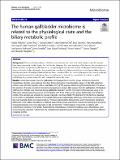Por favor, use este identificador para citar o enlazar a este item:
http://hdl.handle.net/10261/185585COMPARTIR / EXPORTAR:
 SHARE SHARE
 CORE
BASE CORE
BASE
|
|
| Visualizar otros formatos: MARC | Dublin Core | RDF | ORE | MODS | METS | DIDL | DATACITE | |

| Título: | The human gallbladder microbiome is related to the physiological state and the biliary metabolic profile |
Autor: | Molinero, Natalia CSIC ORCID; Ruíz García, Lorena CSIC ORCID ; Milani, Christian; Gutiérrez-Díaz, Isabel CSIC ORCID CVN; Sánchez García, Borja CSIC ORCID; Mangifesta, Marta; Segura, José; Cambero, Isabel; Campelo, Ana B. CSIC; García-Bernardo, Carmen M.; Cabrera, Ana; Rodríguez, José I.; González Solares, Sonia; Rodríguez, Juan M.; Ventura, Marco; Delgado, Susana CSIC ORCID; Margolles Barros, Abelardo CSIC ORCID | Palabras clave: | Bile microbiota Cholelithiasis Microbial bile metabolites Gallstones patients |
Fecha de publicación: | 4-jul-2019 | Editor: | BioMed Central | Citación: | Microbiome 7(1): 100 (2019) | Resumen: | [Background] The microbial populations of the human intestinal tract and their relationship to specific diseases have been extensively studied during the last decade. However, the characterization of the human bile microbiota as a whole has been hampered by difficulties in accessing biological samples and the lack of adequate methodologies to assess molecular studies. Although a few reports have described the biliary microbiota in some hepatobiliary diseases, the bile microbiota of healthy individuals has not been described. With this in mind, the goal of the present study was to generate fundamental knowledge on the composition and activity of the human bile microbiota, as well as establishing its potential relationship with human bile-related disorders. [Results] Human bile samples from the gallbladder of individuals from a control group, without any record of hepatobiliary disorder, were obtained from liver donors during liver transplantation surgery. A bile DNA extraction method was optimized together with a quantitative PCR (qPCR) assay for determining the bacterial load. This allows the selection of samples to perform functional metagenomic analysis. Bile samples from the gallbladder of individuals suffering from lithiasis were collected during gallbladder resection and the microbial profiles assessed, using a 16S rRNA gene-based sequencing analysis, and compared with those of the control group. Additionally, the metabolic profile of the samples was analyzed by nuclear magnetic resonance (NMR). We detected, for the first time, bacterial communities in gallbladder samples of individuals without any hepatobiliary pathology. In the biliary microecosystem, the main bacterial phyla were represented by Firmicutes, Bacteroidetes, Actinobacteria, and Proteobacteria. Significant differences in the relative abundance of different taxa of both groups were found. Sequences belonging to the family Propionibacteriaceae were more abundant in bile samples from control subjects; meanwhile, in patients with cholelithiasis members of the families Bacteroidaceae, Prevotellaceae, Porphyromonadaceae, and Veillonellaceae were more frequently detected. Furthermore, the metabolomics analysis showed that the two study groups have different metabolic profiles. [Conclusions] Our results indicate that the gallbladder of human individuals, without diagnosed hepatobiliary pathology, harbors a microbial ecosystem that is described for the first time in this study. Its bacterial representatives and metabolites are different from those detected in people suffering from cholelithiasis. In this regard, since liver donors have been subjected to the specific conditions of the hospital’s intensive care unit, including an antibiotic treatment, we must be cautious in stating that their bile samples contain a physiologically normal biliary microbiome. In any case, our results open up new possibilities to discover bacterial functions in a microbial ecosystem that has not previously been explored. |
Versión del editor: | https://doi.org/10.1186/s40168-019-0712-8 | URI: | http://hdl.handle.net/10261/185585 | DOI: | 10.1186/s40168-019-0712-8 | E-ISSN: | 2049-2618 |
| Aparece en las colecciones: | (IPLA) Artículos |
Ficheros en este ítem:
| Fichero | Descripción | Tamaño | Formato | |
|---|---|---|---|---|
| human_gallbladder_microbiome_related_physiological_state.pdf | 2,81 MB | Adobe PDF |  Visualizar/Abrir |
CORE Recommender
PubMed Central
Citations
69
checked on 25-abr-2024
SCOPUSTM
Citations
97
checked on 23-abr-2024
WEB OF SCIENCETM
Citations
82
checked on 29-feb-2024
Page view(s)
304
checked on 23-abr-2024
Download(s)
157
checked on 23-abr-2024

